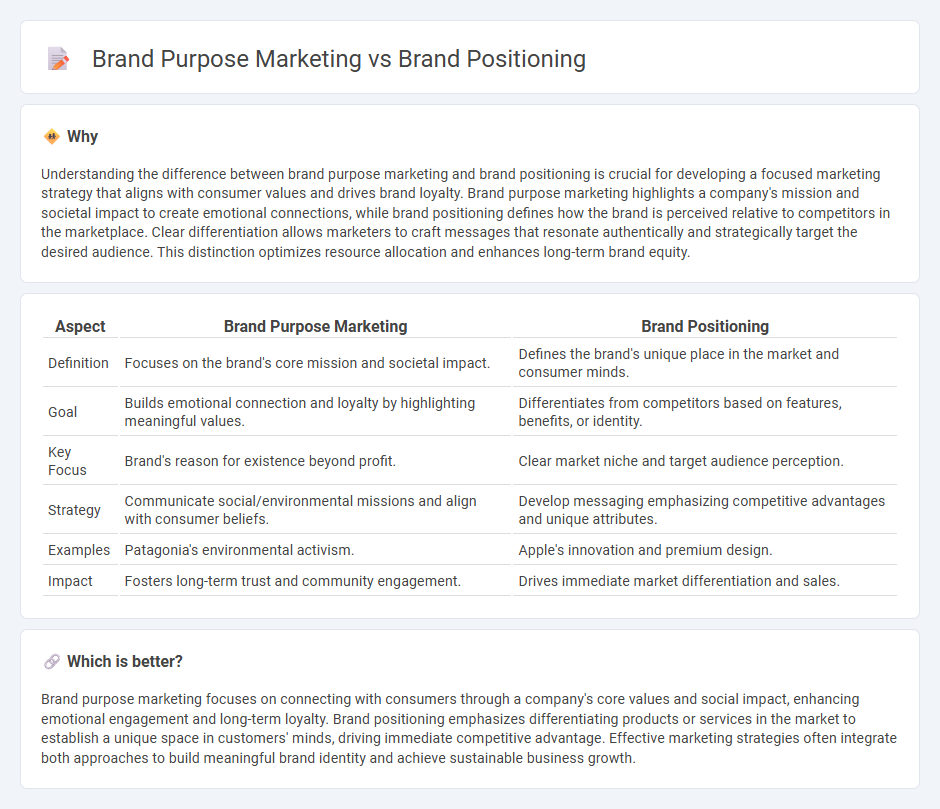
Brand purpose marketing focuses on a company's mission and values to create emotional connections with consumers, emphasizing social responsibility and long-term impact. In contrast, brand positioning defines a brand's unique value proposition and market niche, highlighting distinct attributes that differentiate it from competitors. Explore the key strategies and examples to understand how both approaches drive business success.
Why it is important
Understanding the difference between brand purpose marketing and brand positioning is crucial for developing a focused marketing strategy that aligns with consumer values and drives brand loyalty. Brand purpose marketing highlights a company's mission and societal impact to create emotional connections, while brand positioning defines how the brand is perceived relative to competitors in the marketplace. Clear differentiation allows marketers to craft messages that resonate authentically and strategically target the desired audience. This distinction optimizes resource allocation and enhances long-term brand equity.
Comparison Table
| Aspect | Brand Purpose Marketing | Brand Positioning |
|---|---|---|
| Definition | Focuses on the brand's core mission and societal impact. | Defines the brand's unique place in the market and consumer minds. |
| Goal | Builds emotional connection and loyalty by highlighting meaningful values. | Differentiates from competitors based on features, benefits, or identity. |
| Key Focus | Brand's reason for existence beyond profit. | Clear market niche and target audience perception. |
| Strategy | Communicate social/environmental missions and align with consumer beliefs. | Develop messaging emphasizing competitive advantages and unique attributes. |
| Examples | Patagonia's environmental activism. | Apple's innovation and premium design. |
| Impact | Fosters long-term trust and community engagement. | Drives immediate market differentiation and sales. |
Which is better?
Brand purpose marketing focuses on connecting with consumers through a company's core values and social impact, enhancing emotional engagement and long-term loyalty. Brand positioning emphasizes differentiating products or services in the market to establish a unique space in customers' minds, driving immediate competitive advantage. Effective marketing strategies often integrate both approaches to build meaningful brand identity and achieve sustainable business growth.
Connection
Brand purpose marketing is intrinsically linked to brand positioning as it defines the core mission and values that differentiate a brand in the marketplace. Effective brand positioning aligns this purpose with target audience needs, creating a clear, authentic identity that drives consumer loyalty. By integrating brand purpose, companies enhance emotional engagement, strengthening their market presence and competitive advantage.
Key Terms
Brand Positioning:
Brand positioning defines how a brand is perceived in the minds of the target audience by emphasizing unique attributes, benefits, and values that differentiate it from competitors. Effective brand positioning aligns messaging, visual identity, and customer experience to create a distinct and memorable market presence, often anchored in attributes like quality, innovation, or customer service. Explore deeper strategies on how brand positioning shapes consumer decision-making and drives competitive advantage.
Differentiation
Brand positioning centers on differentiating a product or service in the marketplace by highlighting unique attributes that set it apart from competitors. Brand purpose marketing emphasizes the core mission and values that align with societal impact, fostering emotional connections with consumers. Explore how these strategies interplay to build a compelling and distinctive brand identity.
Target Audience
Brand positioning centers on creating a unique place in the target audience's mind through specific messaging, tone, and visual identity that sets a brand apart from competitors. Brand purpose marketing emphasizes the underlying mission or values that resonate emotionally with the audience, building deeper loyalty by aligning with their beliefs and aspirations. Explore how integrating both strategies effectively engages your target audience and strengthens brand relevance.
Source and External Links
15 Brand Positioning Examples to Refine Your Branding Strategy - Brand positioning is about identifying your unique value and who benefits most from it, involving steps like determining current positioning, understanding competitors, crafting a positioning statement, and reinforcing your brand's uniqueness in the market.
The Ultimate Guide to Brand Positioning Strategy - Adobe - Brand positioning strategies define how a brand is perceived, including approaches like quality-based, price-based, and customer service positioning to differentiate and connect with target audiences.
How to Craft the Perfect Brand Positioning Statement - Crafting a brand positioning statement involves defining your target audience, understanding your competition, and using tools like perceptual maps to clarify how your brand uniquely solves customer needs compared to competitors.
 dowidth.com
dowidth.com